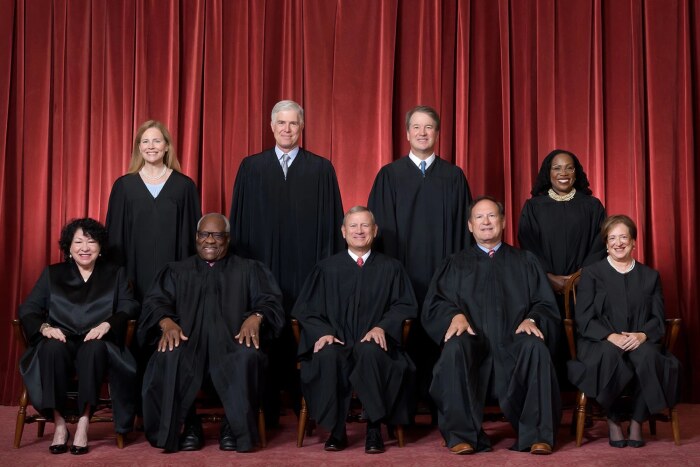Steve Corbin is emeritus professor of marketing at the University of Northern Iowa and a freelance writer who receives no remuneration, funding, or endorsement from any for-profit business, nonprofit organization, political action committee, or political party.
More than a year has passed since the U.S. Supreme Court overturned the Roe v Wade and Casey precedents, stripping women of a right they’d had for nearly 50 years to make their own reproductive health-care decisions. The Dobbs v. Jackson decision has affected American lives in many ways, and had some surprising consequences.
For the first time ever, a majority of Americans say abortion is morally acceptable and recent abortion laws are too strict.
For the first time in two decades, more people identify as “pro-choice” versus “pro-life.”
A recent NBC News poll found voters who oppose the court’s actions in Dobbs include 55 percent of men, 67 percent of women, 66 percent of suburban women, 77 percent of female voters ages 18-49, 92 percent of Democrats, 60 percent of independents, and 31 percent of Republicans.
A Kaiser Family Foundation survey of 569 OB-GYN doctors, taken between March and May 2023, revealed shocking findings: 68 percent found the Dobbs ruling has “worsened their ability to manage pregnancy-related emergencies.” Another 64 percent said the Supreme Court’s decision worsened pregnancy-related mortality, and 70 percent said the same for racial and ethnic inequities in maternal health. About 55 percent said the ruling made it harder to attract new OB-GYNs to the field.
Michele Goodwin, a legal expert in bioethics and health law, wrote in Ms. magazine in May, “A dramatic proliferation in anti-abortion legislation in the United States has coincided with this nation becoming the deadliest in the `developed world’ to be pregnant and attempt to give birth.”
She noted that Black women are 3.5 times more likely to die due to maternal mortality than their white counterparts; banning abortion will not help Black women. The states with the highest maternal mortality rates also lead the nation in anti-abortion legislation.
Writing in the Georgetown Journal of Gender and the Law, Georgetown law student Isabella Oishi pointed out that the so-called Texas Heartbeat Act, which took effect in 2021, did not reduce the need for abortion care. Instead, its enforcement led to an eleven-fold increase in Texans crossing state lines for abortions.
Oishi further argued that state laws prohibiting women from seeking abortions in other states “are likely unconstitutional based on the right to travel, the Privileges and Immunities Clause and the Dormant Commerce Clause. The antiabortion legislation harkens back to the (1793) Fugitive Slave Act.”
In February, U.S. District Court Judge Colleen Kollar-Kotelly speculated “that a constitutional right to abortion may be found in the 13th Amendment.” The U.S. Supreme Court did not consider that possibility in the Dobbs case. The 13th Amendment—ratified at the end of the Civil War in 1865—made slavery and involuntary servitude illegal.
Northwestern law professor Andrew Koppelman made that case in an article called “Forced Labor: A Thirteenth Amendment Defense of Abortion.” He wrote in January,
Forced pregnancy’s violation of personal liberty is obvious. Restrictions on abortion also violate the amendment’s guarantee of equality, because forcing women to be mothers makes them into (what so much tradition defined them as) a servant caste, a group that, by virtue of a status of birth, is held subject to a special duty to serve others and not themselves. (It is also pertinent that abortion restrictions disproportionately burden Black women.)
Legal scholar Elie Mystal wrote in the March 2022 issue of The Nation that states trying to restrict travel for the purpose of obtaining an abortion “are borrowing traces of the sadistic logic and psychological tactics of this country’s enslavers.” Ja’han Jones agreed in a post for MSNBC’s ReidOut blog last month: “with abortion rights being rescinded across the country, it’s more important than ever that we call restrictions on this vital procedure what they actually are: slavery.”
The Supreme Court’s majority decision created unnecessary chaos for 334 million Americans. The repercussions will likely be salient for many voters in the 2024 elections. While Republican candidates largely ignore the harmful impacts of abortion bans, Democratic candidates will tout women’s reproductive rights.
Top image: Official photo of the U.S. Supreme Court justices in 2022, published with permission from the collection of the Supreme Court of the United States. Front row, from left: Justices Sonia Sotomayor, Clarence Thomas, Chief Justice John Roberts, Justices Samuel Alito and Elena Kagan. Back row, from left: Justices Amy Coney Barrett, Neil Gorsuch, Brett Kavanaugh, and Ketanji Brown Jackson.

